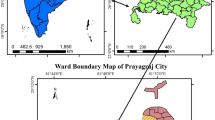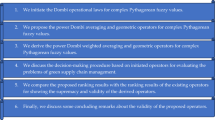Abstract
Recently, sustainable supplier chain management (SSCM) has gained increasing attentions both from corporate and academic. A large number of multiple criteria group decision-making (MCGDM) methods for sustainable supplier selection have been developed. In this paper, considering that the interval type-2 fuzzy sets (IT2FSs) exhibit some interesting properties for handling uncertain information and high order imprecision, we integrate the ANP (analytical network process) method and the VIKOR (ViseKriterijumska Optimizacija I Kompromisno Resenje) method under interval type-2 fuzzy environment to solve supplier selection problem in SSCM. The proposed method consists of two steps. First, we obtain the weights of criteria via the ANP method. Then, based on the weights of criteria presented in step 1, a compromise solution will be proposed with the aid of VIKOR method. A numerical example is presented to show the decision process in detail. In addition, a comparative analysis with interval type-2 fuzzy ANP method and TOPSIS method is also presented to verify the validity of the proposed method.




Similar content being viewed by others
References
Azadi M, Jafarian M, Farzipoor Saen R, Mirhedayatian SM (2015) A new fuzzy DEA model for evaluation of efficiency and effectiveness of suppliers in sustainable supply chain management context. Comput Oper Res 54:274–285
Büyüközkan G, Çifçi G (2012) A novel hybrid MCDM approach based on fuzzy DEMATEL, fuzzy ANP and fuzzy TOPSIS to evaluate green suppliers. Expert Syst Appl 39(3):3000–3011
Carter CR, Jennings MM (2002) Logistics social responsibility: an integrative framework. J Bus Logist 23(1):145–180
Çebi F, Otay İ (2016) A two-stage fuzzy approach for supplier evaluation and order allocation problem with quantity discounts and lead time. Inf Sci 339:143–157
Chardine-Baumann E, Botta-Genoulaz V (2014) A framework for sustainable performance assessment of supply chain management practices. Comput Ind Eng 76:138–147
Chen T-Y (2013) A linear assignment method for multiple-criteria decision analysis with interval type-2 fuzzy sets. Appl Soft Comput 13(5):2735–2748
Chen S-M, Hong J-A (2014) Fuzzy multiple attributes group decision-making based on ranking interval type-2 fuzzy sets and the TOPSIS method. IEEE Trans Syst Man Cybern Syst 44(12):1665–1673
Chen S-M, Kuo L-W (2017) Autocratic decision making using group recommendations based on interval type-2 fuzzy sets, enhanced Karnik–Mendel algorithms, and the ordered weighted aggregation operator. Inf Sci 412–413:174–193
Chen S-M, Lee L-W (2010a) Fuzzy multiple attributes group decision-making based on the interval type-2 TOPSIS method. Expert Syst Appl 37(4):2790–2798
Chen S-M, Lee L-W (2010b) Fuzzy multiple attributes group decision-making based on the ranking values and the arithmetic operations of interval type-2 fuzzy sets. Expert Syst Appl 37(1):824–833
Chen S-M, Lee L-W (2010c) Fuzzy multiple criteria hierarchical group decision-making based on interval type-2 fuzzy sets. IEEE Trans Syst Man Cybern Part A Syst Hum 40(5):1120–1128
Chen S-M, Wang C-Y (2013) Fuzzy decision making systems based on interval type-2 fuzzy sets. Inf Sci 242:1–21
Chen S-M, Yang M-W, Lee L-W, Yang S-W (2012) Fuzzy multiple attributes group decision-making based on ranking interval type-2 fuzzy sets. Expert Syst Appl 39(5):5295–5308
Cheng S-H, Chen S-M, Huang Z-C (2016) Autocratic decision making using group recommendations based on ranking interval type-2 fuzzy sets. Inf Sci 361–362:135–161
Dobos I, Vörösmarty G (2014) Green supplier selection and evaluation using DEA-type composite indicators. Int J Prod Econ 157:273–278
Dou Y, Zhu Q, Sarkis J (2014) Evaluating green supplier development programs with a grey-analytical network process-based methodology. Eur J Oper Res 233(2):420–431
Gonzalez CI, Melin P, Castro JR, Mendoza O, Castillo O (2017) General type-2 fuzzy edge detection in the preprocessing of a face recognition system. In: Melin P, Castillo O, Kacprzyk J (eds) Nature-inspired design of hybrid intelligent systems. Springer, Berlin, pp 3–18
Govindan K, Rajendran S, Sarkis J, Murugesan P (2015) Multi criteria decision making approaches for green supplier evaluation and selection: a literature review. J Clean Prod 98:66–83
Grimm JH, Hofstetter JS, Sarkis J (2014) Critical factors for sub-supplier management: a sustainable food supply chains perspective. Int J Prod Econ 152:159–173
Gupta P, Mehlawat MK, Grover N (2016) Intuitionistic fuzzy multi-attribute group decision-making with an application to plant location selection based on a new extended VIKOR method. Inf Sci 370–371:184–203
Hashemi SH, Karimi A, Tavana M (2015) An integrated green supplier selection approach with analytic network process and improved Grey relational analysis. Int J Prod Econ 159:178–191
Hsu C-W, Kuo T-C, Chen S-H, Hu AH (2013) Using DEMATEL to develop a carbon management model of supplier selection in green supply chain management. J Clean Prod 56:164–172
Igarashi M, de Boer L, Fet AM (2013) What is required for greener supplier selection? A literature review and conceptual model development. J Purch Supply Manag 19(4):247–263
Kahraman C, Öztayşi B, Uçal Sarı İ, Turanoğlu E (2014) Fuzzy analytic hierarchy process with interval type-2 fuzzy sets. Knowl Based Syst 59:48–57
Kannan D, Jabbour ABLdS, Jabbour CJC (2014) Selecting green suppliers based on GSCM practices: using fuzzy TOPSIS applied to a Brazilian electronics company. Eur J Oper Res 233(2):432–447
Kumar A, Jain V, Kumar S (2014) A comprehensive environment friendly approach for supplier selection. Omega 42(1):109–123
Kuo RJ, Hsu CW, Chen YL (2015) Integration of fuzzy ANP and fuzzy TOPSIS for evaluating carbon performance of suppliers. Int J Environ Sci Technol 12(12):3863–3876
Li Y, Liu X, Chen Y (2012) Supplier selection using axiomatic fuzzy set and TOPSIS methodology in supply chain management. Fuzzy Optim Decis Making 11(2):147–176
Lima-Junior FR, Carpinetti LCR (2016) Combining SCOR® model and fuzzy TOPSIS for supplier evaluation and management. Int J Prod Econ 174:128–141
Luthra S, Govindan K, Kannan D, Mangla SK, Garg CP (2017) An integrated framework for sustainable supplier selection and evaluation in supply chains. J Clean Prod 140 Part 3:1686–1698
Mani V, Agrawal R, Sharma V (2014) Supplier selection using social sustainability: AHP based approach in India. Int Strateg Manag Rev 2(2):98–112
Martínez GE, Mendoza DO, Castro JR, Melin P, Castillo O (2017) Choquet integral and interval type-2 fuzzy choquet integral for edge detection. In: Nature-inspired design of hybrid intelligent systems. Springer, pp 79–97
Mendel JM (2007) Type-2 fuzzy sets and systems: an Overview [corrected reprint]. IEEE Comput Intell Mag 2(2):20–29
Mendel JM, John RI, Liu F (2006) Interval type-2 fuzzy logic systems made simple. IEEE Trans Fuzzy Syst 14(6):808–821
Mendel JM, Rajati MR, Sussner P (2016) On clarifying some definitions and notations used for type-2 fuzzy sets as well as some recommended changes. Inf Sci 340–341:337–345
Motevali Haghighi S, Torabi SA, Ghasemi R (2016) An integrated approach for performance evaluation in sustainable supply chain networks (with a case study). J Clean Prod 137:579–597
Najariyan M, Mazandarani M, John R (2017) Type-2 fuzzy linear systems. Granul Comput 2(3):175–186
Olivas F, Valdez F, Castillo O, Gonzalez CI, Martinez G, Melin P (2017) Ant colony optimization with dynamic parameter adaptation based on interval type-2 fuzzy logic systems. Appl Soft Comput 53:74–87
Opricovic S (1998) Multicriteria optimization of civil engineering systems. Fac Civ Eng Belgrad 2(1):5–21
Opricovic S, Tzeng G-H (2002) Multicriteria planning of post-earthquake sustainable reconstruction. Comput Aided Civ Infrastruct Eng 17(3):211–220
Opricovic S, Tzeng G-H (2004) Compromise solution by MCDM methods: a comparative analysis of VIKOR and TOPSIS. Eur J Oper Res 156(2):445–455
Opricovic S, Tzeng G-H (2007) Extended VIKOR method in comparison with outranking methods. Eur J Oper Res 178(2):514–529
Pedrycz W, Chen SM (2015) Granular computing and decision-making: interactive and iterative approaches. Springer Publishing Company, Berlin (Incorporated)
Qin J, Liu X, Pedrycz W (2015) An extended VIKOR method based on prospect theory for multiple attribute decision making under interval type-2 fuzzy environment. Knowl Based Syst 86:116–130
Qin J, Liu X, Pedrycz W (2017) An extended TODIM multi-criteria group decision making method for green supplier selection in interval type-2 fuzzy environment. Eur J Oper Res 258(2):626–638
Rubio E, Castillo O, Valdez F, Melin P, Gonzalez CI, Martinez G (2017) An extension of the fuzzy possibilistic clustering algorithm using type-2 fuzzy logic techniques. Adv Fuzzy Syst 2017(2017-01-31):1–23
Saaty TL (1980) The analytic hierarchical process. McGrow-Hill, New York
Saaty TL (1996) The analytical network process. RWS Publications, Pittsburgh
Saaty TL (2008) The analytic network process. Iran J Oper Res 1(1):1–27
Shaverdi M, Heshmati MR, Eskandaripour E, Tabar AAA (2013) Developing sustainable SCM evaluation model using fuzzy AHP in publishing industry. Procedia Comput Sci 17:340–349
Shen L, Olfat L, Govindan K, Khodaverdi R, Diabat A (2013) A fuzzy multi criteria approach for evaluating green supplier’s performance in green supply chain with linguistic preferences. Resour Conserv Recycl 74:170–179
Shi P, Yan B, Shi S, Ke C (2015) A decision support system to select suppliers for a sustainable supply chain based on a systematic DEA approach. Inf Technol Manag 16(1):39–49
Su C-M, Horng D-J, Tseng M-L, Chiu ASF, Wu K-J, Chen H-P (2016) Improving sustainable supply chain management using a novel hierarchical grey-DEMATEL approach. J Clean Prod 134, Part B:469–481
Tavana M, Shabanpour H, Yousefi S, Farzipoor Saen R (2017) A hybrid goal programming and dynamic data envelopment analysis framework for sustainable supplier evaluation. Neural Comput Appl 28(12):3683–3696
Winter S, Lasch R (2016) Environmental and social criteria in supplier evaluation—lessons from the fashion and apparel industry. J Clean Prod 139:175–190
Wu T, Liu X-W, Liu S-L (2015) A fuzzy ANP with interval type-2 fuzzy sets approach to evaluate enterprise technological innovation ability. In: Paper presented at the fuzzy systems (FUZZ-IEEE), 2015 IEEE international conference on
Yazdani M, Chatterjee P, Zavadskas EK, Zolfani SH (2017) Integrated QFD-MCDM framework for green supplier selection. J Clean Prod 142:3728–3740
Zadeh LA (1975) The concept of a linguistic variable and its application to approximate reasoning—I. Inf Sci 8(3):199–249
Zhou X, Pedrycz W, Kuang Y, Zhang Z (2016) Type-2 fuzzy multi-objective DEA model: an application to sustainable supplier evaluation. Appl Soft Comput 46:424–440
Acknowledgements
The work was supported by the National Natural Science Foundation of China (NSFC) under Project 71701158, MOE (Ministry of Education in China) Project of Humanities and Social Sciences (17YJC630114), and Fundamental Research Funds for the Central Universities under the Projects 2015VI002 and 2017VI010.
Author information
Authors and Affiliations
Corresponding author
Rights and permissions
About this article
Cite this article
Liu, K., Liu, Y. & Qin, J. An integrated ANP-VIKOR methodology for sustainable supplier selection with interval type-2 fuzzy sets. Granul. Comput. 3, 193–208 (2018). https://doi.org/10.1007/s41066-017-0071-4
Received:
Accepted:
Published:
Issue Date:
DOI: https://doi.org/10.1007/s41066-017-0071-4




